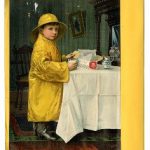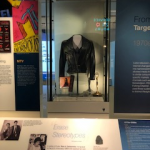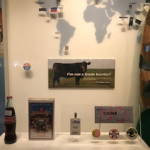By Professor Tiffany Banks On Tuesday, September 30th , students from my COMM 108: Foundations…
by Dr. Hoa Nguyen, Economics
D.C. metropolitan area is one of my favorite places with its dynamic lifestyles, cherry blossoms, and the largest research and museum complex in the world. Strolling through museums and going back in time with each exhibition are my way to detox and relax. Therefore, I am always eager to introduce the museums to out-of-town friends every time they visit D.C. In 2019, I had the pleasure of being a Smithsonian Fellow at Montgomery College (MC) and taking my students to a Smithsonian museum. Many of my students had never been to those museums despite they lived in the area and museums are free of charge. The trip was an opportunity or “an excuse” for them to invite their friends and families out for a quality time together. A student later commented that they were glad the museum visit was mandatory. They probably would never go to a museum otherwise, and would miss out many interesting exhibitions.
The program started with all the fellows checking out the museums in the spring. We had specialists walking us through highlighted exhibitions and sharing behind-the-scene stories. The theme of 2019 was “The Search for an American Identity: Building a Nation Together”, which drew the inspiration from the NMAH’s Many Voices, One Nation exhibit. Who is an American? What does an American look like? Who should be an American? Being an immigrant myself, I constantly struggle with these questions. I feel that I am “not Asian enough” for my Asian friends and families, and “not American enough” for the American side. On top of this, I am an introvert, which makes it extremely hard for me to connect with people in any set up. Taking 30 students out on a daytrip and hanging out with them for hours at the museum sound like a daunting task. However, discussing and sharing ideas with other fellows throughout the spring and early fall semesters helped me have a vision of how I would deploy this project in my ECON202 Principles of Microeconomics class.
A Microeconomics class focuses on principles of how people and firms make decisions in order to maximize their welfare and profit, given their limited resources. I have to find a way to connect questions about American identity with business strategies and market structures. I choose the American Enterprise exhibition at the NMAH to be the source of information and destination of the visit. It shows stories of how American businesses reflect social changes and movements since the beginning of the United States; and how they have changed the world for better or worse. It is a great bridge between the American identity and economic theories because as the American identity evolves with immigration and cultural shifts, firms have to update their business models and products to serve new demands and markets. It is a permanent exhibition so it is easier to plan the visit months in advance because it will always be there. The exhibition is well curated and organized chronologically in four eras: Merchant Era (1770s – 1850s), Corporate Era (1860s – 1930s), Consumer Era (1940s – 1970s), and Global Era (1980s – 2010s). This gives a clear structure for students to navigate through the exhibition. It is on the first floor, which makes finding it easy, especially for students who might come late. It is also right next to the fascinating Transportation exhibition with cars and trains that excite young people and keep them wander in the museum a little longer.
The trip was on Saturday, October 26th. I met up with my students at the front of NMAH. Some came early and waited patiently in line to get in at 10 a.m. They came with their cousins, friends and families. They did a treasure hunt inside the exhibition. Their task was to find an object that represented the idea of “Made in America” the most to them, and write up a reflection essay about that. Students had to describe the object first and identify to which era that the object belonged. Then they had to do a research about where and when it was invented, by whom, and for whom. They had to explain why there was a demand for that product or service; how consumers and competitors responded to it; and how its introduction change the original market as well as the society in general. Moreover, students had to give a definition of what is considered “Made in America” in their opinion and justify why their chosen object satisfies that definition.
I guided them to think through (but not limited to) parts of the object, and see where they were made, by whom, and where those workers or makers came from. If the workers were not originally from the U.S., students had to think about what quality, standards or business models could make products made by foreign workers worthy of the “Made in America” stamp. By nudging students to think beyond a dry definition of an American trademark in business, the assignment was designed to help them see how market forces evolve over time and reflect changes in the American modern society. It poked them to think about who are considered American workers, for whom they produce, and how their products shatter old limitation while open new horizons.
The trip was aligned with the section about market structures. It is because the American Enterprise exhibition is full of stories about businesses compete with each other to take over market segments. That process is how a market transforms from monopoly to competitive structure and vice versa. I used objects from the exhibition in my lectures before and after the trip to remind students about their relevance and application of Economic theories in real life throughout history. For example, I told the anecdotes about British Hudson’s Bay Company’s fur operation in Dakota and Minnesota territories; and how the Metis people broke the monopoly by transporting their fur south to St. Paul, where they received better prices in a more competitive market. A big fur cart was displayed at the NMAH. This showed students the concept of market’s invisible hand, and how “Made in America” might not mean that it was made by Americans. I talked about the invention of lightweight tractors that revolutionized agriculture in the U.S., and created the glowing image of modern American farmers in the early 20th century. Students got a chance to see for themselves the Waterloo boy and Fordson tractors at the museum. Later, they told me how much they liked the machines there. They also saw that instead of being stereotyped and ignored, minority groups were finally recognized as potential market segments. However, firms often used commercials to manipulate consumers and their identities such as being white middle-class, using all-American products and boycotting Chinese products, etc.

Slicker Boy commercials
targeted mainly white, middle class consumers
 Celebrities and businesses started promoting products and services for minorities in 1950s – 1980s
Celebrities and businesses started promoting products and services for minorities in 1950s – 1980s

“No China” poster from a protest against international trade

Students posed in front of the Fordson tractor, which represents “Made in America” trademark
Overall, the daytrip went smoothly. While students checking out the exhibition, I walked around to see if they had any questions or just wanted to chitchat. I asked them about what captured their attention or made them wonder. They all seemed to please with what they saw, even for some students who were familiar with the exhibition from previous visits because the treasure hunt assignment forced them to pay more attention to the narratives. One student said, “Outside learning experience makes learning more fun”. Another one said, “Hands-on learning was a very valuable experience. It was enjoyable for both my family and myself. It was a learning experience for all of us that day.” A first time visitor commented that the atmosphere at the museum was very nice and the exhibition was interesting. Some others enjoyed the collaboration with each other and said that it connected them outside classroom. Their comments sound like music to my ears. This was the first time that I took a big group of students out all by myself. Looking back at the long-term preparation and anxiety attacks, I am grateful for all the discussion and support from our cohort. If I can do this, anybody can do it too! And I guarantee they will enjoy it just like I did.





Hi Hoa, I am looking forward to meeting you in just a couple of weeks at LEAP Advance. One of the things we do at LEAP Advance is that a team of LEAP Advance faculty write letters welcoming each program participant. I got luck and drew your name. I am now in the process of doing some background research on you and drafting a letter that you should receive during the first week of July … assuming that I can actually finish the letter.
This was a wonderful field trip. I can relate to your students because I did not feel comfortable in museums, but you made them both comfortable and curious. What a gift you gave them. Pat Hayashi